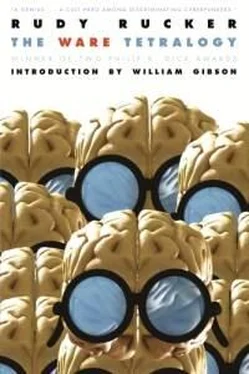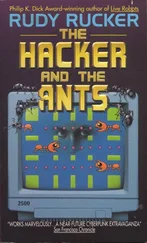Rudy Rucker - The Ware Tetralogy
Здесь есть возможность читать онлайн «Rudy Rucker - The Ware Tetralogy» весь текст электронной книги совершенно бесплатно (целиком полную версию без сокращений). В некоторых случаях можно слушать аудио, скачать через торрент в формате fb2 и присутствует краткое содержание. Год выпуска: 2010, Жанр: Киберпанк, на английском языке. Описание произведения, (предисловие) а так же отзывы посетителей доступны на портале библиотеки ЛибКат.
- Название:The Ware Tetralogy
- Автор:
- Жанр:
- Год:2010
- ISBN:нет данных
- Рейтинг книги:5 / 5. Голосов: 1
-
Избранное:Добавить в избранное
- Отзывы:
-
Ваша оценка:
- 100
- 1
- 2
- 3
- 4
- 5
The Ware Tetralogy: краткое содержание, описание и аннотация
Предлагаем к чтению аннотацию, описание, краткое содержание или предисловие (зависит от того, что написал сам автор книги «The Ware Tetralogy»). Если вы не нашли необходимую информацию о книге — напишите в комментариях, мы постараемся отыскать её.
The Ware Tetralogy — читать онлайн бесплатно полную книгу (весь текст) целиком
Ниже представлен текст книги, разбитый по страницам. Система сохранения места последней прочитанной страницы, позволяет с удобством читать онлайн бесплатно книгу «The Ware Tetralogy», без необходимости каждый раз заново искать на чём Вы остановились. Поставьте закладку, и сможете в любой момент перейти на страницу, на которой закончили чтение.
Интервал:
Закладка:
Babs’s show was called “Realware Worms,” and it featured twenty of her worm-farms. Some were the ones she’d been making before she got the alla: mazes of plastic tubing filled with soil and a mixture of real and imipolex DIM worms. Just to play with the categories a little, Babs had also made some new versions of these, using alla-made realware biological worms in place of “wild” biological worms. In addition, she’d alla-made a half-dozen large transparent shapes filled solid with writhing DIM worms. There were cubes of plastic worms, some big doughnut shapes, and even a mounting, squiggly spiral like a moonshiner’s “worm coil” condenser. That last one had been Randy’s suggestion, he was proud to say. To fill out the show, Babs hung a lot of her lace on the walls and alla-made seven variations on her cartoonlike dune buggy, giving them hard “kandy kolors” that marched up the spectrum: red, orange, yellow, green, blue, indigo, violet. Babs put smiling worm logos on the car doors so they’d fit the show’s theme, and parked the “worm buggies” in a cutely angled row on the sidewalk outside the Asiz.
The title of the show was a good idea, as everyone was still in the process of trying to assimilate what “Realware” might mean. There was a big crowd on opening night—the guests all decked out in freaky S.F. outfits like never before seen—but the sales were disastrously weak. The potential customers seemed to want to go home and make their own copies of Babs’s works with their allas. In fact, one woman with a beehive hairdo and a skirt made of dangling transparent dildos stood out on the sidewalk staring really hard at one of the worm-buggies for half an hour and then— whoosh— used her alla to make her own version, using the same base-model Metamartian alla catalog dune buggy that Babs had used. The art on the knockoff worm buggy wasn’t quite the same, for it came out of the dildo-skirted woman’s head and not Babs’s, but it seemed to suit her well enough, and maybe better. She hopped in her new car and drove off , with Randy running after her down the street shouting empty threats.
The situation with the lace was a bit different. The decorations of the worm-buggies were big and easy to mentally represent, but the lace simply had too much pattern, produced as it was by colonies of interacting DIM-based fabricants. No casual gallery-goer would be able to mentally specify the twists and turns of all the lace knots for his or her alla. Even so, Randy did catch a tipsy man in orange leather leaving the gallery wearing a mantilla of crude knockoff lace on his shoulders. Rather than being knotted, the copied lace’s threads were simply fused at the crossings. And the overall pattern repeated itself every four inches, instead of subtly varying all along the mantilla’s length.
The plastic worms were the least susceptible to copying, as it was their living behavior that made them art. Their flocking, their wriggling, their subtly oscillating hues—all of these were based on limpware DIM designs that Babs had invented for them with Randy’s help. And there was no way to “see” these microscopic code designs just by looking at the worms. Yet everyone was in such a do-it-yourself frenzy with their allas that they seemed to overlook this fact.
The sole person to offer to purchase one of Babs’s works was a sleek banker named Chock Fresser. Fresser wanted to acquire the show’s centerpiece: a twelve-foot transparent pretzel filled with imipolex worms in a thousand different shades of blue and green; it was called “Wowo Worms.”
But Fresser didn’t want to take delivery on the physical item; he wanted Babs to uvvy him a copy of the software design so he could alla-make the work in situ at his house. “Too much trouble to ship it home,” said Fresser. “Packing, unpacking—who needs it anymore? Give me the code and that way I can bring ‘Wowo Worms’ in and out of storage as needed.”
The gallery owner, Kundry Asiz, was a good friend of Babs’s from high school. When Babs suggested to her that they shouldn’t sell the code to Fresser since money didn’t matter anymore, Kundry pointed out that, yes, there was a sense in which money didn’t matter anymore, but there were still several senses in which it did—first of all, it was crass human nature for people to give more attention and respect to art they had to pay for, and secondly, the rent on a space like the Asiz Gallery was something the alla couldn’t finagle them out of.
So Babs agreed, and Fresser walked off with the complete code for the “Wowo Worms.” And a week later, tacky little desktop copies of it were for sale in every gift shop on Fisherman’s Wharf—with nary an attribution to Babs. Kundry put some heavy pressure on Fresser and got him to triple the original purchase price, but it wasn’t a fully satisfying resolution.
“We gotta figure out a way to sell a design for onetime use only,” said Randy. He and Babs were sitting on the ant-decorated couch in Babs’s warehouse. Babs’s brother Saint was there too. It was the first of May.
“Use a one-time encryption zip,” said Saint. “I learned about that stuff when I was working for Meta West. You can zip your design and send the zipped version to the user with an unzipper that trashes itself after its first use. Like cheap pants. The first time you open the fly, the zipper sticks for good. You can publish the image of your work in the alla catalog, and when somebody orders it, they get a single zip of the design with its own unzipper. And of course the unzipper is tailored only to feed the information into an alla and not into any kind of a storage device.”
“I get it,” said Babs. “I could make an art catalog that’s like a catalog used to be. There’s just images of things, and you have to uvvy in some funds to take delivery on an item. And if you want another one, you have to pay again. That’s a brilliant idea, Saint. I wish I’d known about that before.”
“Live and learn, sis,” said Saint. “Just think about the poor companies that had every one of their products put into the Metamartian alla catalog.”
“Like Modern Rocks,” said Randy. He liked his Spider-Man gloves and anemone boots so much that he’d looked into the fate of their manufacturer. “I found out they really did go down the tubes. The Metamartians didn’t leave no holes. Whatever the aliens put in that catalog is there one hundred percent, the whole design coded up in nanotech blueprints.
Those Metamartians did their homework. Now, this trick of yours, Saint, is everyone gonna know about it? It would be good to spread it around, so’s artists and inventors can get some kind of reward.”
“Maybe I should sell my trick,” said Saint. “Call it the One-Zip. If I can actually figure out the details. I’m not really that much of a programmer. But you two sure went for it. Yeah, I need someone to help me productize.”
“Why is everyone always talking about buying and selling these days?” said Yoke impatiently. She’d just walked in. “You sound like a bunch of businessman numberskulls. Guys with calculator DIMs in their heads. Phil’s the worst of all. Going on and on about selling his blimps. Money lags! What does anyone need xoxxin’ money for anyway? And meanwhile people are killing each other for fun.” Without waiting for a response, Yoke stalked across the room to study the pair of huge aquariums she’d installed. One contained a realware South Pacific reef with hard and soft corals. The biologicals were all alla-made realware: primarily coral polyps and the diatoms they fed upon. The other tank held Yoke’s workin-progress, a colony of miniaturized limpware polyps that were supposed to build an artificial reef. Yoke’s polyps weren’t doing so well today. When he’d gotten up this morning. Randy had noticed that Yoke’s artificial reef had petered out into ugly little crumbly excrescences, not at all like the smooth, branching staghorn shapes she was shooting for.
Читать дальшеИнтервал:
Закладка:
Похожие книги на «The Ware Tetralogy»
Представляем Вашему вниманию похожие книги на «The Ware Tetralogy» списком для выбора. Мы отобрали схожую по названию и смыслу литературу в надежде предоставить читателям больше вариантов отыскать новые, интересные, ещё непрочитанные произведения.
Обсуждение, отзывы о книге «The Ware Tetralogy» и просто собственные мнения читателей. Оставьте ваши комментарии, напишите, что Вы думаете о произведении, его смысле или главных героях. Укажите что конкретно понравилось, а что нет, и почему Вы так считаете.











